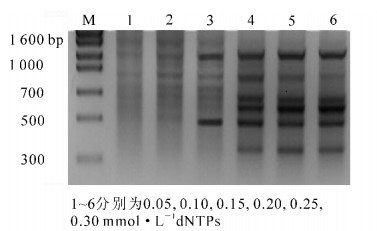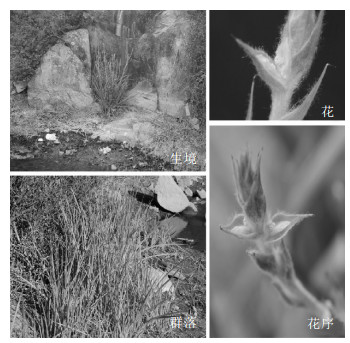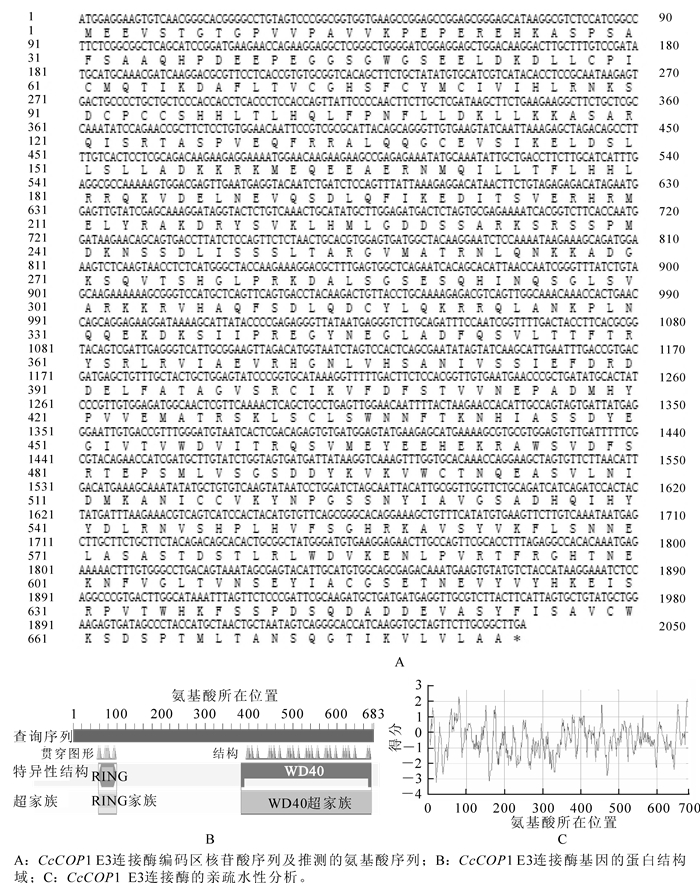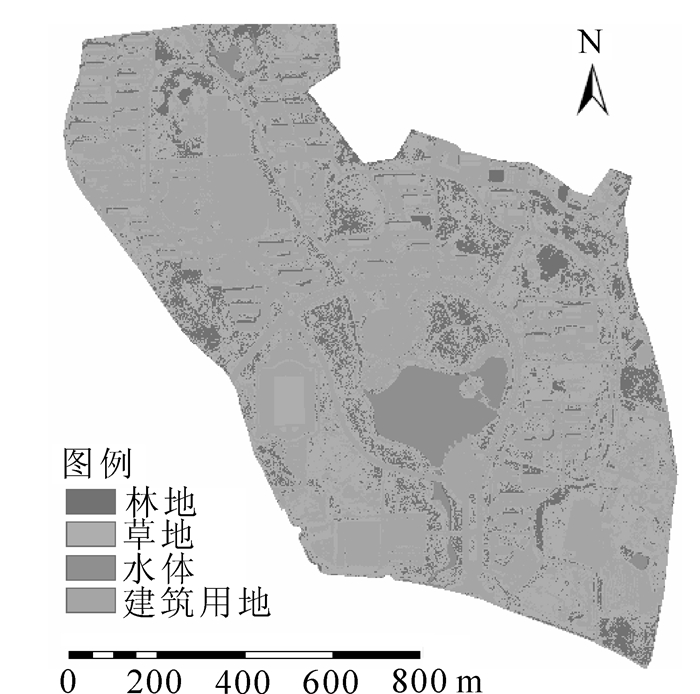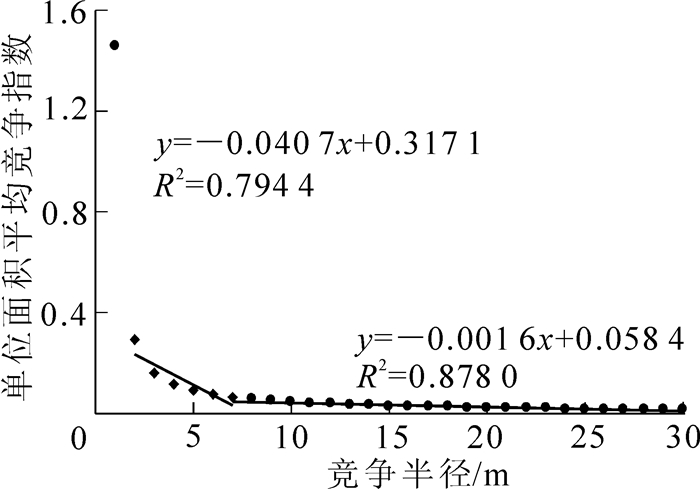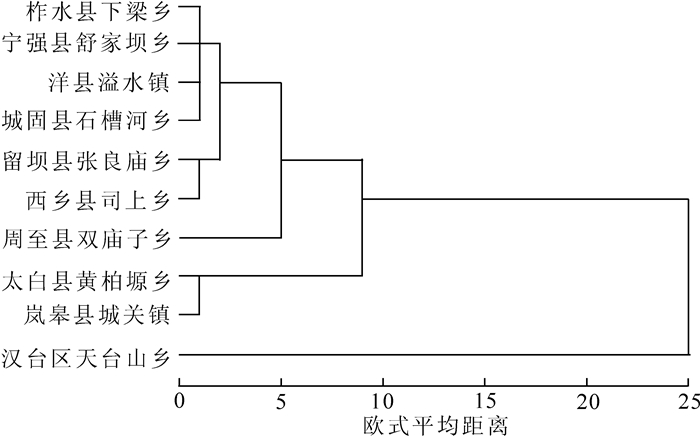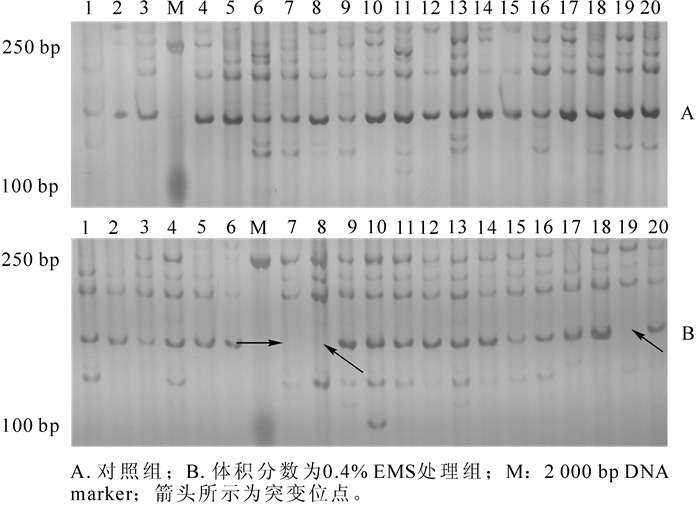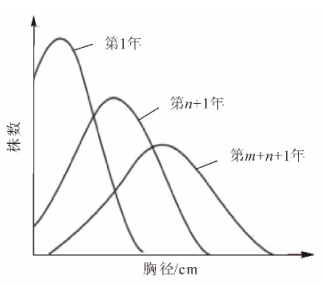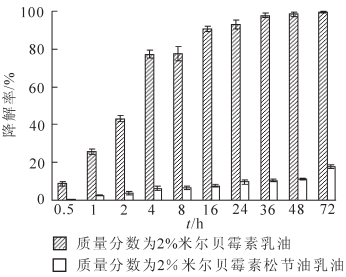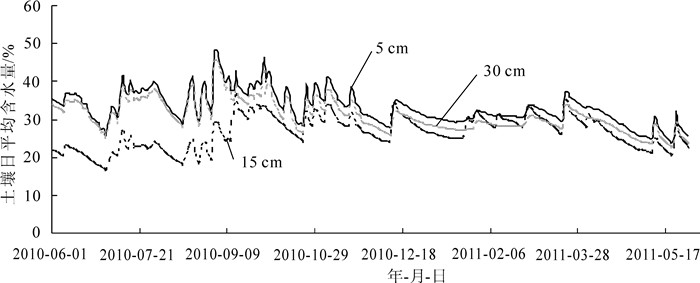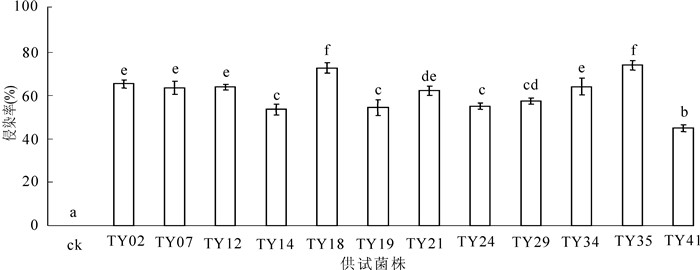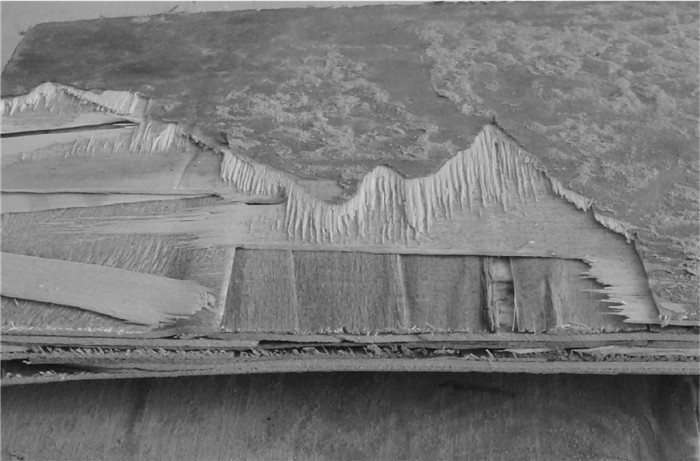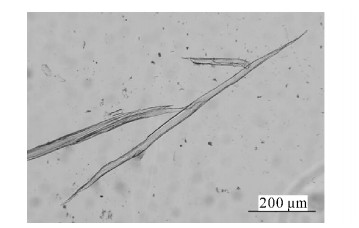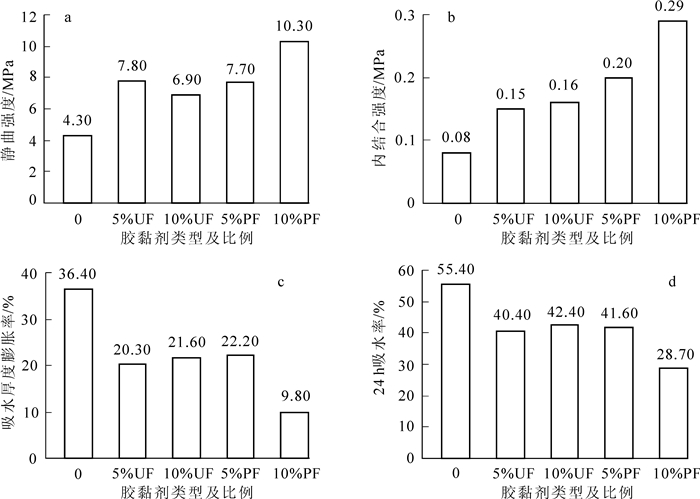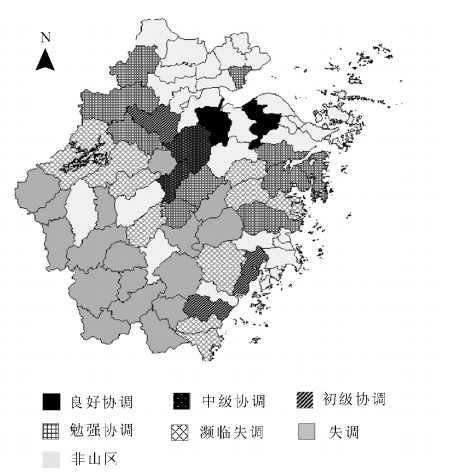2014 Vol. 31, No. 6
2014, 31(6): 983-989.
doi: 10.11833/j.issn.2095-0756.2014.06.023
Abstract:
In order to select a stable inter-simple sequence repeat-polymerase chain reaction (ISSR-PCR) system for Paris polyphylla, a single factor experiment and an orthogonal design were combined and applied in this study. Concentrations for parameters were determined in a 25.0 μL system. Results revealed an optimized reaction system with concentrations of 0.2 mmol·L-1 dNTPs, 0.75×16.67 nkat (0.75 U) Taq DNA polymerase, Mg2+ 2.0 mmol·L-1, 0.6 μmol·L-1 primer, and 40 ng DNA template. The optimal annealing temperature was 52℃ for primer ISSR2. This study of an ISSR-PCR reaction system with high stability, repeatability, and detective polymorphism ability has laid a technical foundation for germplasm resource identification and genetic diversity analyses of P. polyphylla.
In order to select a stable inter-simple sequence repeat-polymerase chain reaction (ISSR-PCR) system for Paris polyphylla, a single factor experiment and an orthogonal design were combined and applied in this study. Concentrations for parameters were determined in a 25.0 μL system. Results revealed an optimized reaction system with concentrations of 0.2 mmol·L-1 dNTPs, 0.75×16.67 nkat (0.75 U) Taq DNA polymerase, Mg2+ 2.0 mmol·L-1, 0.6 μmol·L-1 primer, and 40 ng DNA template. The optimal annealing temperature was 52℃ for primer ISSR2. This study of an ISSR-PCR reaction system with high stability, repeatability, and detective polymorphism ability has laid a technical foundation for germplasm resource identification and genetic diversity analyses of P. polyphylla.
2014, 31(6): 990-991.
doi: 10.11833/j.issn.2095-0756.2014.06.024
Abstract:
A new record species Philydurm lanuginosum Banks et Sol. ex Gaertn. was found in Xiangshan, Ningbo, Zhejiang Province. This species, and its corresponding genus Philydrum Bands et Sol. ex. Gaertn. and the family Philydraceae are all new recorded. Its morphological characteristics, habitat, and usage were described. The voucher specimens are deposited in the plants herbarium of Zhejiang A & F University (ZJFC).
A new record species Philydurm lanuginosum Banks et Sol. ex Gaertn. was found in Xiangshan, Ningbo, Zhejiang Province. This species, and its corresponding genus Philydrum Bands et Sol. ex. Gaertn. and the family Philydraceae are all new recorded. Its morphological characteristics, habitat, and usage were described. The voucher specimens are deposited in the plants herbarium of Zhejiang A & F University (ZJFC).
2014, 31(6): 823-830.
doi: 10.11833/j.issn.2095-0756.2014.06.001
Abstract:
To gain new insight into the male sterile characters of seedless Ougan, homologous cloning was undertaken for clones of full length cDNAs of CsLTP (lipid transfer protein) and CsLOX (lipoxygenase) genes of seedless Ougan(Citrus suavissima 'Seedless'). Then, bioinformatic analyses were performed online to predict the characteristics of encoded proteins. The expression model of CsLTP and CsLOX with pollen development was analyzed through real time polymerase chain reaction (PCR), and statistic analysis was performed by Duncan's multiple comparison test. The cDNA of CsLTP was 667 bp in length encoding 215 amino acids, which was similar to LTPs of Citrus sinensis (95%) and Citrus jambhiri (60%). The cDNA of CsLOX was 2 915 bp in length encoding 895 amino acids, which was similar to LOXs of C. jambhiri (99%) and Populus (51%). Compared to seedy Ougan, the mRNA transcripts of CsLTP and CsLOX in seedless Ougan decreased noticeably (P < 0.05) after the pollen formation stage leading to aberrant lipid transportation and oxygenation in seedless Ougan. Thus, the turbulence of lipid metabolism was related to pollen abortion in seedless Ougan.
To gain new insight into the male sterile characters of seedless Ougan, homologous cloning was undertaken for clones of full length cDNAs of CsLTP (lipid transfer protein) and CsLOX (lipoxygenase) genes of seedless Ougan(Citrus suavissima 'Seedless'). Then, bioinformatic analyses were performed online to predict the characteristics of encoded proteins. The expression model of CsLTP and CsLOX with pollen development was analyzed through real time polymerase chain reaction (PCR), and statistic analysis was performed by Duncan's multiple comparison test. The cDNA of CsLTP was 667 bp in length encoding 215 amino acids, which was similar to LTPs of Citrus sinensis (95%) and Citrus jambhiri (60%). The cDNA of CsLOX was 2 915 bp in length encoding 895 amino acids, which was similar to LOXs of C. jambhiri (99%) and Populus (51%). Compared to seedy Ougan, the mRNA transcripts of CsLTP and CsLOX in seedless Ougan decreased noticeably (P < 0.05) after the pollen formation stage leading to aberrant lipid transportation and oxygenation in seedless Ougan. Thus, the turbulence of lipid metabolism was related to pollen abortion in seedless Ougan.
2014, 31(6): 831-837.
doi: 10.11833/j.issn.2095-0756.2014.06.002
Abstract:
COP1 E3 ligase is a photomorphogenic repressor, a molecular switch for light control in plant development. A fragment of CcCOP1 E3 ligase for Carya cathayensis (hickory) was obtained with 454 sequencing. Then, the rapid amplification of cDNA ends (RACE) method was used to obtain the full length of the COP1 E3 ligase gene. Analysis was conducted with reverse transcription polymerase chain reaction (RT-PCR) and included a comparison between CcCOP1 E3 ligase and COP1 E3 ligase. Results showed that the full-length of COP1 E3 ligase was 2 331 bp and consisted of two special structural domains:an annular zinc finger domain and WD-40 repeat sequences with the coding protein being strongly hydrophilic. The end of the amino was mainly hydrophilic amino acids; whereas, the end of the carboxyl was mostly hydrophobic amino acids. The identity between CcCOP1 E3 ligase and COP1 E3 ligase in Populus trichocarpa reached 77.8%. Results of the RT-PCR illustrated that expression of CcCOP1 E3 ligase in hickory occurred throughout the development of staminate and pistillate flowers. The gene expressed in stems, leaves, fruits, and flower buds had the highest expression in the flower bud with a peak in the middle of March; however, the male flower bud had its peak in the middle of May. Expression for the staminate flower peaked on March 12th and for the pistillate flower in the middle of May. Thus, it was supposed that COP1 E3 ligase was relevant to the differentiation of pistillate and staminate flowers in hickory.
COP1 E3 ligase is a photomorphogenic repressor, a molecular switch for light control in plant development. A fragment of CcCOP1 E3 ligase for Carya cathayensis (hickory) was obtained with 454 sequencing. Then, the rapid amplification of cDNA ends (RACE) method was used to obtain the full length of the COP1 E3 ligase gene. Analysis was conducted with reverse transcription polymerase chain reaction (RT-PCR) and included a comparison between CcCOP1 E3 ligase and COP1 E3 ligase. Results showed that the full-length of COP1 E3 ligase was 2 331 bp and consisted of two special structural domains:an annular zinc finger domain and WD-40 repeat sequences with the coding protein being strongly hydrophilic. The end of the amino was mainly hydrophilic amino acids; whereas, the end of the carboxyl was mostly hydrophobic amino acids. The identity between CcCOP1 E3 ligase and COP1 E3 ligase in Populus trichocarpa reached 77.8%. Results of the RT-PCR illustrated that expression of CcCOP1 E3 ligase in hickory occurred throughout the development of staminate and pistillate flowers. The gene expressed in stems, leaves, fruits, and flower buds had the highest expression in the flower bud with a peak in the middle of March; however, the male flower bud had its peak in the middle of May. Expression for the staminate flower peaked on March 12th and for the pistillate flower in the middle of May. Thus, it was supposed that COP1 E3 ligase was relevant to the differentiation of pistillate and staminate flowers in hickory.
2014, 31(6): 838-846.
doi: 10.11833/j.issn.2095-0756.2014.06.003
Abstract:
The light-harvesting chlorophyll a/b binding protein (LHCB) gene plays an important role in plants adapting to various environments. Sedum alfredii is a new Zn/Cd hyper-accumulator and whether LHCB in this interesting species was related to the heavy-metal tolerance interested us a lot. In the present study, we isolated a cDNA using homologous cloning and designated it as SaLhcb2 which encoded a light-harvesting chlorophyll a/b binding protein in Sedum alfredii. A prelimary sequence analysis was conducted and homologous comparison was also performed using MegAlign. In order to identify the gene expression profiles of SaLhcb2 response to heavy-metal stress, seedlings of Sedum alfredii were treated by 400 μmol·L-1 Cd2+, Cu2+, and Pb2+ stresses with those cultured in water as a control. Roots, stems and leaves were dissected and promptly frozen in liquid nitrogen for RNA extraction and the followed real-time PCR. Sequence analysis showed that the coding sequence of SaLhcb2 was 929 bp and the open reading frame was 798 bp. The deduced protein, SaLHCB2, consisted of 266 amino acids and had a high homology (above 92%) with LHCB2 of other plants via homologous comparison. For the Cd2+, Cu2+, and Pb2+ stress treatments, the level of SaLhcb2 was elevated dramatically in stems and leaves within 12.0 h. However, with the Cd2+ treatment, the expression of SaLhcb2 in roots did not display a tendency of up-regulation until 48.0 h. For the Cu2+ treatment, in roots, the expression of SaLhcb2 showed a prompt response of up-regulation at 0.5 h and then decreased weirdly. With the Pb2+ treatment, the expression of SaLhcb2 in roots displayed a profile of down-regulation except the point of 96.0 h. Based on the above findings, it could be concluded that the expression of SaLhcb2 in Sedum alfredi was influenced by heavy-metal treatment and may function in the process of plants combating heavy-metal stress.
The light-harvesting chlorophyll a/b binding protein (LHCB) gene plays an important role in plants adapting to various environments. Sedum alfredii is a new Zn/Cd hyper-accumulator and whether LHCB in this interesting species was related to the heavy-metal tolerance interested us a lot. In the present study, we isolated a cDNA using homologous cloning and designated it as SaLhcb2 which encoded a light-harvesting chlorophyll a/b binding protein in Sedum alfredii. A prelimary sequence analysis was conducted and homologous comparison was also performed using MegAlign. In order to identify the gene expression profiles of SaLhcb2 response to heavy-metal stress, seedlings of Sedum alfredii were treated by 400 μmol·L-1 Cd2+, Cu2+, and Pb2+ stresses with those cultured in water as a control. Roots, stems and leaves were dissected and promptly frozen in liquid nitrogen for RNA extraction and the followed real-time PCR. Sequence analysis showed that the coding sequence of SaLhcb2 was 929 bp and the open reading frame was 798 bp. The deduced protein, SaLHCB2, consisted of 266 amino acids and had a high homology (above 92%) with LHCB2 of other plants via homologous comparison. For the Cd2+, Cu2+, and Pb2+ stress treatments, the level of SaLhcb2 was elevated dramatically in stems and leaves within 12.0 h. However, with the Cd2+ treatment, the expression of SaLhcb2 in roots did not display a tendency of up-regulation until 48.0 h. For the Cu2+ treatment, in roots, the expression of SaLhcb2 showed a prompt response of up-regulation at 0.5 h and then decreased weirdly. With the Pb2+ treatment, the expression of SaLhcb2 in roots displayed a profile of down-regulation except the point of 96.0 h. Based on the above findings, it could be concluded that the expression of SaLhcb2 in Sedum alfredi was influenced by heavy-metal treatment and may function in the process of plants combating heavy-metal stress.
2014, 31(6): 847-849.
doi: 10.11833/j.issn.2095-0756.2014.06.004
Abstract:
A new species of Ochidaceae, Bulbophyllum Thou., B. ningboense G. Y. Li ex H. L. Lin et X. P. Li from Fenghua County of Zhejiang, China is described in this paper. The new species is morphologically similar to B. chrondriophorum (Gagnep.) Seidenf., but differs in having pseudobulbs close to each other or apart from; leaves 12.0-15.0 mm long; scape obviously longer than blade, a joint with one membranous cybmo-sheath at mid-lower part of scape; lateral sepals 8.0-9.0 mm long; dorsal sepal ovate-lanceolate, 3-veined; dorsal sepals and petals glabrous at margin; petals ca. 2.0 mm long.
A new species of Ochidaceae, Bulbophyllum Thou., B. ningboense G. Y. Li ex H. L. Lin et X. P. Li from Fenghua County of Zhejiang, China is described in this paper. The new species is morphologically similar to B. chrondriophorum (Gagnep.) Seidenf., but differs in having pseudobulbs close to each other or apart from; leaves 12.0-15.0 mm long; scape obviously longer than blade, a joint with one membranous cybmo-sheath at mid-lower part of scape; lateral sepals 8.0-9.0 mm long; dorsal sepal ovate-lanceolate, 3-veined; dorsal sepals and petals glabrous at margin; petals ca. 2.0 mm long.
2014, 31(6): 850-859.
doi: 10.11833/j.issn.2095-0756.2014.06.005
Abstract:
To model the carbon budget trend at Zhejiang A & F University over 2012 and to measure the carbon budget on a campus-level scale, a system dynamics model was developed using Vensim.The parametric data of the model was based on the observed data from Li-COR 6400 and Li-COR 8100. Results showed that the carbon emission for 2012 was 4 147.48 t·a-1 and per square meter discharge of 3.24 t·m-2·a-1 on average, meaning the campus was a carbon source to the atmosphere. Carbon emissions from human activities was 5 555.45 t·month-1, and per person discharge of 0.024 t·month-1 on average. Emissions from electricity consumption were the largest among all kinds of human activities. The carbon sink for plants reached 1 407.96 t·a-1 which meant per square meter of green space fixed an average of 187 g·month-1 of C. The seasonal change of C sequestration showed bimodal characteristics, appearing higher in spring and autumn, but lowest in winter. Compared to original conditions, by simultaneously controlling the carbon sink for green space (increased to 224 g·m-2), the per capita energy consumption (decreased to 428.55 g·d-1), and the transport energy consumption(decreased to 163 kg·d-1); the low-carbon scenario achieved a 29% reduction in carbon emissions.
To model the carbon budget trend at Zhejiang A & F University over 2012 and to measure the carbon budget on a campus-level scale, a system dynamics model was developed using Vensim.The parametric data of the model was based on the observed data from Li-COR 6400 and Li-COR 8100. Results showed that the carbon emission for 2012 was 4 147.48 t·a-1 and per square meter discharge of 3.24 t·m-2·a-1 on average, meaning the campus was a carbon source to the atmosphere. Carbon emissions from human activities was 5 555.45 t·month-1, and per person discharge of 0.024 t·month-1 on average. Emissions from electricity consumption were the largest among all kinds of human activities. The carbon sink for plants reached 1 407.96 t·a-1 which meant per square meter of green space fixed an average of 187 g·month-1 of C. The seasonal change of C sequestration showed bimodal characteristics, appearing higher in spring and autumn, but lowest in winter. Compared to original conditions, by simultaneously controlling the carbon sink for green space (increased to 224 g·m-2), the per capita energy consumption (decreased to 428.55 g·d-1), and the transport energy consumption(decreased to 163 kg·d-1); the low-carbon scenario achieved a 29% reduction in carbon emissions.
2014, 31(6): 860-867.
doi: 10.11833/j.issn.2095-0756.2014.06.006
Abstract:
According to the UK PAS2050 product carbon footprint assessment standard, the paper assesses the carbon dioxide emissions of flattened bamboo chopping board's transportation, processing and supply chain inputs and the product's efficiency of carbon storage. It gets the footprint (pure carbon equivalent) by putting them together. We get the data through tracking the product's life cycle, including the raw materials, the production process and distribution (B2B). And then, it analyses the composition of carbon footprint and impact factors. The study shows, 1 piece of specifications for 360 mm×240 mm×17 mm flattered bamboo chopping board's carbon footprint is 0.168 3 kg CO2 equivalent. Transportation's emission is 0.041 7 kg CO2 equivalent. The production process emission is 0.041 7 kg CO2 equivalent. The addendum's emission is 0.063 3 kg CO2 equivalent. 1 piece of flattered bamboo chopping board's efficiency of carbon storage is -0.117 2 kg CO2 equivalent.
According to the UK PAS2050 product carbon footprint assessment standard, the paper assesses the carbon dioxide emissions of flattened bamboo chopping board's transportation, processing and supply chain inputs and the product's efficiency of carbon storage. It gets the footprint (pure carbon equivalent) by putting them together. We get the data through tracking the product's life cycle, including the raw materials, the production process and distribution (B2B). And then, it analyses the composition of carbon footprint and impact factors. The study shows, 1 piece of specifications for 360 mm×240 mm×17 mm flattered bamboo chopping board's carbon footprint is 0.168 3 kg CO2 equivalent. Transportation's emission is 0.041 7 kg CO2 equivalent. The production process emission is 0.041 7 kg CO2 equivalent. The addendum's emission is 0.063 3 kg CO2 equivalent. 1 piece of flattered bamboo chopping board's efficiency of carbon storage is -0.117 2 kg CO2 equivalent.
2014, 31(6): 868-876.
doi: 10.11833/j.issn.2095-0756.2014.06.007
Abstract:
To protect and obtain sustainable utilization of a forest, studying intraspecific and interspecific competition is important and meaningful. This research used adjacent grid points to obtain data, and the best competitive scope for the designated forest of Longwang Mountain was determined by expanding gradually. To quantitatively analyze the intraspecific and interspecific competition of the dominant species, the Hegyi Competition Index was used and one typical plot of 100 m×100 m was surveyed. Results demonstrated that expanding the scope effectively defined dominant trees. The average competition intensity decreased quickly with the increasing of zone in a certain zone while it had a littile decrease beyond the zone. When the sample radius was 7 m, the average for interspecific competition per unit area stabilized with 12 dominant tree species, including Pterostyrax corymbosus, Cornus kousa, Malus baccata, Castanea seguinii, Cornus controversa, Styrax obassia, Fagus engleriana, Quercus stewardii, Cyclocarya paliurus, Symplocos chinensis, Castanea henryi, and Pyrus betulifolia. Intraspecific competition was stronger for Malus baccata, Pterostyrax corymbosus, Cornus kousa, and Fagus engleriana populations than the other dominant species partially because the distribution pattern was clumped. Strong intraspecific competition between species of Cornus controversa, Styrax obassia, Symplocos chinensis, and Cyclocarya paliurus versus species of Pterostyrax corymbosus and Cornus kousa showed that they had similar niche requirements. In addition, Pterostyrax corymbosus and Cornus kousa were the largest competitors of the other dominant species. Thus, Hegyi competition model could provide a reliable basis for studying on intraspecific and interspecific competition of dominant species in a deciduous, broadleaf forest of Longwang Mountain.
To protect and obtain sustainable utilization of a forest, studying intraspecific and interspecific competition is important and meaningful. This research used adjacent grid points to obtain data, and the best competitive scope for the designated forest of Longwang Mountain was determined by expanding gradually. To quantitatively analyze the intraspecific and interspecific competition of the dominant species, the Hegyi Competition Index was used and one typical plot of 100 m×100 m was surveyed. Results demonstrated that expanding the scope effectively defined dominant trees. The average competition intensity decreased quickly with the increasing of zone in a certain zone while it had a littile decrease beyond the zone. When the sample radius was 7 m, the average for interspecific competition per unit area stabilized with 12 dominant tree species, including Pterostyrax corymbosus, Cornus kousa, Malus baccata, Castanea seguinii, Cornus controversa, Styrax obassia, Fagus engleriana, Quercus stewardii, Cyclocarya paliurus, Symplocos chinensis, Castanea henryi, and Pyrus betulifolia. Intraspecific competition was stronger for Malus baccata, Pterostyrax corymbosus, Cornus kousa, and Fagus engleriana populations than the other dominant species partially because the distribution pattern was clumped. Strong intraspecific competition between species of Cornus controversa, Styrax obassia, Symplocos chinensis, and Cyclocarya paliurus versus species of Pterostyrax corymbosus and Cornus kousa showed that they had similar niche requirements. In addition, Pterostyrax corymbosus and Cornus kousa were the largest competitors of the other dominant species. Thus, Hegyi competition model could provide a reliable basis for studying on intraspecific and interspecific competition of dominant species in a deciduous, broadleaf forest of Longwang Mountain.
2014, 31(6): 877-884.
doi: 10.11833/j.issn.2095-0756.2014.06.008
Abstract:
On the basis of landscape ecology theories, the spatial layout and construction of ecological corridors in Cangnan County, Zhejiang Province were studied with GIS technology. In the context of regional ecological suitability analysis, the ecological source was identified and the potential ecological corridors were constructed through the cumulative cost distance model and compared with the existing ecological corridors. The results indicated that in the northeastern plains in Cangnan County, the number and area of ecological patches were small; connectivity among patches was low and landscape fragmentation was serious. As major ecological corridors characterized by small size and service area, roads and rivers had low connectivity among them and did not form a good ecological network. In the western, southern and northwestern mountains with good ecological habitats, the ecological patches were larger but unevenly distributed. Especially, in the central and western regions, the number of ecological patches was small; the connectivity among both patches and corridors was low. Through the analysis of the above problems, ecological corridors including roads, rivers and green belts in the research site were optimized and constructed to realize the maximum functions of ecological corridors.
On the basis of landscape ecology theories, the spatial layout and construction of ecological corridors in Cangnan County, Zhejiang Province were studied with GIS technology. In the context of regional ecological suitability analysis, the ecological source was identified and the potential ecological corridors were constructed through the cumulative cost distance model and compared with the existing ecological corridors. The results indicated that in the northeastern plains in Cangnan County, the number and area of ecological patches were small; connectivity among patches was low and landscape fragmentation was serious. As major ecological corridors characterized by small size and service area, roads and rivers had low connectivity among them and did not form a good ecological network. In the western, southern and northwestern mountains with good ecological habitats, the ecological patches were larger but unevenly distributed. Especially, in the central and western regions, the number of ecological patches was small; the connectivity among both patches and corridors was low. Through the analysis of the above problems, ecological corridors including roads, rivers and green belts in the research site were optimized and constructed to realize the maximum functions of ecological corridors.
2014, 31(6): 885-891.
doi: 10.11833/j.issn.2095-0756.2014.06.009
Abstract:
To reveal the phenotypic variation of wild Lilium lancifolium and to determine variation in characteristics of phenotypic diversity within and among populations, three stem characters, five leaf characters and eight flower characters in 30 plants from each of 10 populations in L. lancifolium native to southern Shaanxi Province were chosen as materials based on field investigations and analysis of the natural population. Analysis of variance, correlation analysis, and cluster analysis were carried out for 16 quantitative traits, such as stem diameter, blade number, flower number and so on. Results indicated (1) the average variation coefficient varied from 2.1% (length of filament) to 35.4% (number of flowers), and the average coefficient of variation among populations ranged between 7.5% (populations native to Tiantaishan Town in Hantai County) and 17.2% (populations native to Shicaohe Town in Chenggu County). (2) The correlation analysis showed that altitude was significantly and positively correlated to quantitative traits of flower number (r=0.684, P < 0.05, n=10), width-length ratio of outside petals (r=0.651, P < 0.05, n=10) and width of stigmas (r=0.729, P < 0.05, n=10), and was significantly and negatively correlated to width-length ratio of middle leaves (r=-0.743, P < 0.05, n=10) and filament length(r=-0.795, P < 0.01, n=10). Habitat was significantly and positively correlated to quantitative traits of stem height (r=0.733, P < 0.01, n=10), blade number (r=0.718, P < 0.01, n=10) and flower number (r=0.752, P < 0.01, n=10), and was significantly and negatively correlated to width-length ratio of top leaves (r=-0.707, P < 0.05, n=10) and width-length ratio of inside petals (r=-0.681, P < 0.05, n=10). (3) The cluster analysis showed that the 10 wild populations could be divided into two groups with the population native to Tiantaishan Town in Hantai County forming one cluster. These findings offer basic data for further studies on genetic breeding and conservation biology of this species.
To reveal the phenotypic variation of wild Lilium lancifolium and to determine variation in characteristics of phenotypic diversity within and among populations, three stem characters, five leaf characters and eight flower characters in 30 plants from each of 10 populations in L. lancifolium native to southern Shaanxi Province were chosen as materials based on field investigations and analysis of the natural population. Analysis of variance, correlation analysis, and cluster analysis were carried out for 16 quantitative traits, such as stem diameter, blade number, flower number and so on. Results indicated (1) the average variation coefficient varied from 2.1% (length of filament) to 35.4% (number of flowers), and the average coefficient of variation among populations ranged between 7.5% (populations native to Tiantaishan Town in Hantai County) and 17.2% (populations native to Shicaohe Town in Chenggu County). (2) The correlation analysis showed that altitude was significantly and positively correlated to quantitative traits of flower number (r=0.684, P < 0.05, n=10), width-length ratio of outside petals (r=0.651, P < 0.05, n=10) and width of stigmas (r=0.729, P < 0.05, n=10), and was significantly and negatively correlated to width-length ratio of middle leaves (r=-0.743, P < 0.05, n=10) and filament length(r=-0.795, P < 0.01, n=10). Habitat was significantly and positively correlated to quantitative traits of stem height (r=0.733, P < 0.01, n=10), blade number (r=0.718, P < 0.01, n=10) and flower number (r=0.752, P < 0.01, n=10), and was significantly and negatively correlated to width-length ratio of top leaves (r=-0.707, P < 0.05, n=10) and width-length ratio of inside petals (r=-0.681, P < 0.05, n=10). (3) The cluster analysis showed that the 10 wild populations could be divided into two groups with the population native to Tiantaishan Town in Hantai County forming one cluster. These findings offer basic data for further studies on genetic breeding and conservation biology of this species.
2014, 31(6): 892-897.
doi: 10.11833/j.issn.2095-0756.2014.06.010
Abstract:
To obtaining the mutants of Pyrus betulifolia, different concentrations (0, 0.1%, 0.2%, 0.3%, 0.4%, 0.5%, 0.6%, 0.7%, 0.8%, 0.9%) of ethyl methane sulphonate (EMS) were used to induce seeds after stratification. Then, seed germination percentage was determined, sequence-related amplified polymorphism (SRAP) markers were used to identify mutant loci, and phenotypic measurements of plant height and internode length of the seedlings were made. Results showed that the half lethal dose of EMS concentration was 0.3%. Combined with SRAP markers detection and phenotypic data analysis, the optimum concentration of EMS treatment was 0.4%, and the mutation rate was 37.3%. Meanwhile, the phenotypic data analysis which used SPSS revealed that plant height with different EMS treatments was significantly lower (P=0.01) than the ck group. These results should provide a valuable theoretical basis for effectively obtaining pear mutants.
To obtaining the mutants of Pyrus betulifolia, different concentrations (0, 0.1%, 0.2%, 0.3%, 0.4%, 0.5%, 0.6%, 0.7%, 0.8%, 0.9%) of ethyl methane sulphonate (EMS) were used to induce seeds after stratification. Then, seed germination percentage was determined, sequence-related amplified polymorphism (SRAP) markers were used to identify mutant loci, and phenotypic measurements of plant height and internode length of the seedlings were made. Results showed that the half lethal dose of EMS concentration was 0.3%. Combined with SRAP markers detection and phenotypic data analysis, the optimum concentration of EMS treatment was 0.4%, and the mutation rate was 37.3%. Meanwhile, the phenotypic data analysis which used SPSS revealed that plant height with different EMS treatments was significantly lower (P=0.01) than the ck group. These results should provide a valuable theoretical basis for effectively obtaining pear mutants.
2014, 31(6): 898-904.
doi: 10.11833/j.issn.2095-0756.2014.06.011
Abstract:
To predict growth of an entire forest, the least squares method was used with experimental and empirical data of a stand to reconstruct each parameter in Richards's equation. Then the average growth quantity was obtained through the predicted equation, and the increment was reasonably distributed to each tree according to an increment distribution model based on the principle of "the strong stronger, the weak weaker". For predicted stand growth, a new algorithm portraying the whole stand growth model developed from the single tree growth model was presented. For this, the whole stand growth model, from Richards's equation, was used to predict the average growth of a stand as a growth factor in the overall volume, then the overall growth increment was reasonably assigned to each tree by an incremental distribution model working from the whole to the individual. To prove this method was correct, an experiment on stand growth modeling was carried out using experimental data from Chinese fir (Cunninghamia lanceolata) stands in Hunan Province's Youxian Huangfengqiao Forest Farm. Results showed that this new model avoided problems with a competition model when studying complex issues among trees and with stand growth when used as a general law for growth in a forest.
To predict growth of an entire forest, the least squares method was used with experimental and empirical data of a stand to reconstruct each parameter in Richards's equation. Then the average growth quantity was obtained through the predicted equation, and the increment was reasonably distributed to each tree according to an increment distribution model based on the principle of "the strong stronger, the weak weaker". For predicted stand growth, a new algorithm portraying the whole stand growth model developed from the single tree growth model was presented. For this, the whole stand growth model, from Richards's equation, was used to predict the average growth of a stand as a growth factor in the overall volume, then the overall growth increment was reasonably assigned to each tree by an incremental distribution model working from the whole to the individual. To prove this method was correct, an experiment on stand growth modeling was carried out using experimental data from Chinese fir (Cunninghamia lanceolata) stands in Hunan Province's Youxian Huangfengqiao Forest Farm. Results showed that this new model avoided problems with a competition model when studying complex issues among trees and with stand growth when used as a general law for growth in a forest.
2014, 31(6): 905-910.
doi: 10.11833/j.issn.2095-0756.2014.06.012
Abstract:
To verify synergistic activity and stability of milbemycin in turpentine, turpentine oil and ethanol with a solvent mixture of milbemycin were measured. Virulence was tested on the carmine spider mite (Tetranychus cinnabarinus) using a leaf disc spray. A photolysis experiment was conducted to determine the stability of milbemycin, and a Gas Chromatography-Mass Spectrography (GC-MS) analysis was performed. Results showed that toxicities of different milbemycin oil in lethal concentration 50 (LC50) values on female adult mites were 0.031 4 and 0.139 0 mg·L-1 with a poison coefficient of 442.68 reflecting a strong synergistic activity. The photolysis experiment showed that turpentine oil as a solvent could improve the stability of milbemycins. The GC-MS analysis revealed that the content of alpha-pinene, camphene, R-limonene and 3-carene was over 60%. Since the main reason for synergistic activity was favorable osmosis of terpene chemicals entering the insect cuticle, turpentine could be used as a solvent and synergistic agent for processing milbemycin green oil preparations.
To verify synergistic activity and stability of milbemycin in turpentine, turpentine oil and ethanol with a solvent mixture of milbemycin were measured. Virulence was tested on the carmine spider mite (Tetranychus cinnabarinus) using a leaf disc spray. A photolysis experiment was conducted to determine the stability of milbemycin, and a Gas Chromatography-Mass Spectrography (GC-MS) analysis was performed. Results showed that toxicities of different milbemycin oil in lethal concentration 50 (LC50) values on female adult mites were 0.031 4 and 0.139 0 mg·L-1 with a poison coefficient of 442.68 reflecting a strong synergistic activity. The photolysis experiment showed that turpentine oil as a solvent could improve the stability of milbemycins. The GC-MS analysis revealed that the content of alpha-pinene, camphene, R-limonene and 3-carene was over 60%. Since the main reason for synergistic activity was favorable osmosis of terpene chemicals entering the insect cuticle, turpentine could be used as a solvent and synergistic agent for processing milbemycin green oil preparations.
2014, 31(6): 911-918.
doi: 10.11833/j.issn.2095-0756.2014.06.013
Abstract:
In order to evaluate the water conservation function under forest soil, a Phyllostachys edulis bamboo stand and a Leptochloa chinensis grassland in the Tongshan Forestry Farm of Nanjing were selected with four sets (2 replications) of Decagon Em50 Data Loggers used to measure daily average soil Volumetric Water Content (VWC) at depths of 5, 15, and 30 cm with air humidity measured at a 2.0 m height for a year. All data were recorded continuously every 15 minutes. Results in the bamboo stand and grass land showed that (1) daily average soil VWC at 5 cm was 33.02%, at 15 cm was 26.16%, and at 30 cm was 30.60% with the lowest (at 15 cm) having the greatest root weight, root length, and soil compaction. In the grassland daily average soil VWC at corresponding depths was lower than the bamboo stand. For the 0-40 cm soil layer, the average annual VWC in the bamboo stand with thick litter on the ground was 9.12% higher than the grassland, improving by 43.41%. (2) For each land use type the average annual CV for daily average soil VWC was negatively and significantly correlated (R2>0.9, P < 0.001) to average annual soil VWC, varying between 8.70%-16.80% in the grassland and 13.9%-16.4% in the bamboo stand. Thus, due to plant roots and litter, daily average soil VWC in corresponding soil layers of the bamboo stand had better water conservation capabilities than the grassland. It is believed to be useful in water conservation forest construction with bamboo. (3) Simulated with exponential function model, seasonal daily average soil VWC correlated significantly (R2>0.9, P < 0.001) with rain day interval for different soil layers, which could be used to help predict drought and to assist in drought control management.
In order to evaluate the water conservation function under forest soil, a Phyllostachys edulis bamboo stand and a Leptochloa chinensis grassland in the Tongshan Forestry Farm of Nanjing were selected with four sets (2 replications) of Decagon Em50 Data Loggers used to measure daily average soil Volumetric Water Content (VWC) at depths of 5, 15, and 30 cm with air humidity measured at a 2.0 m height for a year. All data were recorded continuously every 15 minutes. Results in the bamboo stand and grass land showed that (1) daily average soil VWC at 5 cm was 33.02%, at 15 cm was 26.16%, and at 30 cm was 30.60% with the lowest (at 15 cm) having the greatest root weight, root length, and soil compaction. In the grassland daily average soil VWC at corresponding depths was lower than the bamboo stand. For the 0-40 cm soil layer, the average annual VWC in the bamboo stand with thick litter on the ground was 9.12% higher than the grassland, improving by 43.41%. (2) For each land use type the average annual CV for daily average soil VWC was negatively and significantly correlated (R2>0.9, P < 0.001) to average annual soil VWC, varying between 8.70%-16.80% in the grassland and 13.9%-16.4% in the bamboo stand. Thus, due to plant roots and litter, daily average soil VWC in corresponding soil layers of the bamboo stand had better water conservation capabilities than the grassland. It is believed to be useful in water conservation forest construction with bamboo. (3) Simulated with exponential function model, seasonal daily average soil VWC correlated significantly (R2>0.9, P < 0.001) with rain day interval for different soil layers, which could be used to help predict drought and to assist in drought control management.
2014, 31(6): 919-925.
doi: 10.11833/j.issn.2095-0756.2014.06.014
Abstract:
To determine the relative contribution of fungi and bacteria to soil N2O production in Phyllostachys edulis and broadleaf forest ecosystems and to further study the impact of forest type on soil N2O emission when converting from a broadleaf forest to a Ph. edulis forest, an incubation experiment with soils collected from different forest types was conducted. Four broadleaf and Ph. edulis forest with similar topograph were selected randomly, and toplayer (0-20 cm) soils were sampled. Soil phospholipid fatty acids (PLFAs) were extracted and analyzed to measure the soil microbial biomass. To study the relative contribution of fungi and bacteria to soil N2O emissions, a selective inhibition experiment with addition of different antibiotics (streptomycin and/or cycloheximide, and an antibiotic-free control) was established using a random complete block design. Soil water content was adjusted to 90% water-filled pore space and N2O production was measured by gas chromatography after 7 h of incubation. Student's t-test and Pearson's correlation were used for statistical comparisons and correlation analyses, separately. Results indicated that fungal biomass was significantly and highly correlated with soil organic matter content (R2=0.965, P < 0.01) and significantly and negatively correlated with pH (R2=-0.752, P < 0.05). No significant differences for N2O flux between Ph. edulis and a broadleaf forest were found. For the two forest types, fungi contributed significantly more (P < 0.05) to soil N2O fluxes (40.8%-56.2% with Ph. edulis and 8.0%-62.8% for the broadleaf forest) than bacteria (9.0%-33.4% with Ph. edulis and 12.6%-32.4% in the broadleaf forest). The correlation analyses showed that the fungi and bacteria for these two forest types had similar N2O flux patterns (P < 0.01), but they were not correlated to biomass. Thus, the conversion of a broadleaf forest to Ph. edulis did not increase the N2O flux; denitrification activity of specific fungal species may also play a more important role in soil fungi originated N2O emissions than the fungal biomass.
To determine the relative contribution of fungi and bacteria to soil N2O production in Phyllostachys edulis and broadleaf forest ecosystems and to further study the impact of forest type on soil N2O emission when converting from a broadleaf forest to a Ph. edulis forest, an incubation experiment with soils collected from different forest types was conducted. Four broadleaf and Ph. edulis forest with similar topograph were selected randomly, and toplayer (0-20 cm) soils were sampled. Soil phospholipid fatty acids (PLFAs) were extracted and analyzed to measure the soil microbial biomass. To study the relative contribution of fungi and bacteria to soil N2O emissions, a selective inhibition experiment with addition of different antibiotics (streptomycin and/or cycloheximide, and an antibiotic-free control) was established using a random complete block design. Soil water content was adjusted to 90% water-filled pore space and N2O production was measured by gas chromatography after 7 h of incubation. Student's t-test and Pearson's correlation were used for statistical comparisons and correlation analyses, separately. Results indicated that fungal biomass was significantly and highly correlated with soil organic matter content (R2=0.965, P < 0.01) and significantly and negatively correlated with pH (R2=-0.752, P < 0.05). No significant differences for N2O flux between Ph. edulis and a broadleaf forest were found. For the two forest types, fungi contributed significantly more (P < 0.05) to soil N2O fluxes (40.8%-56.2% with Ph. edulis and 8.0%-62.8% for the broadleaf forest) than bacteria (9.0%-33.4% with Ph. edulis and 12.6%-32.4% in the broadleaf forest). The correlation analyses showed that the fungi and bacteria for these two forest types had similar N2O flux patterns (P < 0.01), but they were not correlated to biomass. Thus, the conversion of a broadleaf forest to Ph. edulis did not increase the N2O flux; denitrification activity of specific fungal species may also play a more important role in soil fungi originated N2O emissions than the fungal biomass.
2014, 31(6): 926-931.
doi: 10.11833/j.issn.2095-0756.2014.06.015
Abstract:
To measure growth and N accumulation in two-year-old Rhododendron annae seedlings, twelve ericoid mycorrhiza (ERM) fungal strain isolates were used for inoculation. The test design set 13 treatments (including ck), each disposed 5 trees, 3 times repeated. The inoculated method was soil inoculation. Results showed that ERM fungi colonized the seedling roots improving biomass of seedling aboveground and belowground parts. Compared to uninoculated controls, inoculation with different ERM strains showed a highly significant increase (P < 0.01) for N content in the leaves and roots of seedlings as well as nitrate reductase (NR) activity. Root N content increased 2.0%-40.3%, and foliar N increased 2.8%-50.6%. Except for TY14, root NR activity was higher than the control (0.9%-29.3%), and except for TY41 and TY24, foliar NR activity was higher than the control 6.5%-43.9%. NR activity in different organs showed root>leaf. ERM fungal strain promoted the growth, NR activity and N content of R. annae seedlings, which meant to promote seedling nitrogen absorption and utilization. Effects of mycorrhiza varied by different ERM fungi strain.
To measure growth and N accumulation in two-year-old Rhododendron annae seedlings, twelve ericoid mycorrhiza (ERM) fungal strain isolates were used for inoculation. The test design set 13 treatments (including ck), each disposed 5 trees, 3 times repeated. The inoculated method was soil inoculation. Results showed that ERM fungi colonized the seedling roots improving biomass of seedling aboveground and belowground parts. Compared to uninoculated controls, inoculation with different ERM strains showed a highly significant increase (P < 0.01) for N content in the leaves and roots of seedlings as well as nitrate reductase (NR) activity. Root N content increased 2.0%-40.3%, and foliar N increased 2.8%-50.6%. Except for TY14, root NR activity was higher than the control (0.9%-29.3%), and except for TY41 and TY24, foliar NR activity was higher than the control 6.5%-43.9%. NR activity in different organs showed root>leaf. ERM fungal strain promoted the growth, NR activity and N content of R. annae seedlings, which meant to promote seedling nitrogen absorption and utilization. Effects of mycorrhiza varied by different ERM fungi strain.
2014, 31(6): 932-939.
doi: 10.11833/j.issn.2095-0756.2014.06.016
Abstract:
To set a technical basis for foliar fertilizer application when cultivating hybrid hazelnut, a L16(45) orthogonal design method was used to study the effects of foliar N, P, and K applications on yield and fruit quality of hybrid hazelnut and to select appropriate N, P, K ratios in the Beijing District. In the experiment, we used three kinds of fertilizer:N, P, and K. And the application rate of N was 0 g·kg-1, 1.2 g·kg-1, 2.5 g·kg-1, and 3.5 g·kg-1; the application rate of P was 0 g·kg-1, 1.8 g·kg-1, 2.6 g·kg-1, and 3.7 g·kg-1; the application rate of K was 0 g·kg-1, 2.6 g·kg-1, 5.2 g·kg-1, and 7.9 g·kg-1. Results showed that a foliar application of 3.5 g·kg-1 N at the shoot growing stage significantly increased the yield (P=0.012) and the single grain weight (P=0.042) of hybrid hazelnut, but P and K did not. The foliar application of N, P, and K did not affect the apparent quality of hybrid hazelnut significantly except 3.7 g·kg-1 P, it increased the fruit diameter (P=0.022) and the rate of shell (P=0.003) of hybrid hazelnut significantly. The application of 1.2 g·kg-1 N reduced the crude protein content significantly (P=0.024); the application of 2.6 g·kg-1 P significantly increased the crude protein content (P=0.049) and significantly reduced the crude fat content (P=0.029); the application of 5.2 g·kg-1K and 7.9 g·kg-1 K significantly increased the crude fat content (P5.2=0.044, P7.9=0.014); the application of 2.6 g·kg-1 K significantly reduced the crude protein content (P=0.013) and significantly increased the soluble sugar content (P=0.028). For the sixteen treatments, Tr14, Tr15, and Tr16 increased hybrid hazelnut yield the most; compared to no fertilization the effects were an increase of 278.1% for Tr14, 159.5% for Tr15, and 373.7% for Tr16. The best combination was 3.5 g·kg-1 N, 3.7 g·kg-1 P, and 0 g·kg-1 K. According to this comprehensive analysis, yield and fruit quality of hybrid hazelnut improved the most with Tr14 and Tr16.
To set a technical basis for foliar fertilizer application when cultivating hybrid hazelnut, a L16(45) orthogonal design method was used to study the effects of foliar N, P, and K applications on yield and fruit quality of hybrid hazelnut and to select appropriate N, P, K ratios in the Beijing District. In the experiment, we used three kinds of fertilizer:N, P, and K. And the application rate of N was 0 g·kg-1, 1.2 g·kg-1, 2.5 g·kg-1, and 3.5 g·kg-1; the application rate of P was 0 g·kg-1, 1.8 g·kg-1, 2.6 g·kg-1, and 3.7 g·kg-1; the application rate of K was 0 g·kg-1, 2.6 g·kg-1, 5.2 g·kg-1, and 7.9 g·kg-1. Results showed that a foliar application of 3.5 g·kg-1 N at the shoot growing stage significantly increased the yield (P=0.012) and the single grain weight (P=0.042) of hybrid hazelnut, but P and K did not. The foliar application of N, P, and K did not affect the apparent quality of hybrid hazelnut significantly except 3.7 g·kg-1 P, it increased the fruit diameter (P=0.022) and the rate of shell (P=0.003) of hybrid hazelnut significantly. The application of 1.2 g·kg-1 N reduced the crude protein content significantly (P=0.024); the application of 2.6 g·kg-1 P significantly increased the crude protein content (P=0.049) and significantly reduced the crude fat content (P=0.029); the application of 5.2 g·kg-1K and 7.9 g·kg-1 K significantly increased the crude fat content (P5.2=0.044, P7.9=0.014); the application of 2.6 g·kg-1 K significantly reduced the crude protein content (P=0.013) and significantly increased the soluble sugar content (P=0.028). For the sixteen treatments, Tr14, Tr15, and Tr16 increased hybrid hazelnut yield the most; compared to no fertilization the effects were an increase of 278.1% for Tr14, 159.5% for Tr15, and 373.7% for Tr16. The best combination was 3.5 g·kg-1 N, 3.7 g·kg-1 P, and 0 g·kg-1 K. According to this comprehensive analysis, yield and fruit quality of hybrid hazelnut improved the most with Tr14 and Tr16.
2014, 31(6): 940-946.
doi: 10.11833/j.issn.2095-0756.2014.06.017
Abstract:
To illustrate comprehensive utilization of limited resources, recycled poplar cement formwork fiber was manufactured into fiberboard. In this study basic properties of fibers and fiberboard were characterized. Then, the effect of density and glue consumption on the mechanical and physical properties of the fiberboard was studied followed by a comparative analysis with ordinary poplar fiberboard via a single factor duplicate test. Results showed that the carbon (C) content of the recycled poplar cement formwork fiberboard was higher than that of poplar veneer by about 5.7%; whereas the oxygen (O) content was lower about 3.3%. Bulk density of recycled cement formwork fibers was equal to that of poplar fibers. When board density was 0.75 g·cm-3 and glue consumption was 12.0%, both mechanical properties and thickness swelling (TS) were maximized and were greater than the general fiberboard. Thus, it was possible to manufacture qualified fiberboard to meet Chinese standards using recycled poplar cement formwork instead of poplar.
To illustrate comprehensive utilization of limited resources, recycled poplar cement formwork fiber was manufactured into fiberboard. In this study basic properties of fibers and fiberboard were characterized. Then, the effect of density and glue consumption on the mechanical and physical properties of the fiberboard was studied followed by a comparative analysis with ordinary poplar fiberboard via a single factor duplicate test. Results showed that the carbon (C) content of the recycled poplar cement formwork fiberboard was higher than that of poplar veneer by about 5.7%; whereas the oxygen (O) content was lower about 3.3%. Bulk density of recycled cement formwork fibers was equal to that of poplar fibers. When board density was 0.75 g·cm-3 and glue consumption was 12.0%, both mechanical properties and thickness swelling (TS) were maximized and were greater than the general fiberboard. Thus, it was possible to manufacture qualified fiberboard to meet Chinese standards using recycled poplar cement formwork instead of poplar.
2014, 31(6): 947-953.
doi: 10.11833/j.issn.2095-0756.2014.06.018
Abstract:
Crotches of Salix discolor, a fast-growing wood with great potential as a reinforced material in wood-based panels. Study the material properties and find out the appropriate process parameters of manufacturing scrimber of Salix discolor by using PF for adhesives. Not only alleviate the problem of shortage of raw materials has also increased the planting area of economic income. The study were analyzed with a scanning electron microscope (SEM) and infrared spectrometer. Fiber morphology, chemical composition, and adhesive interface were then determined; next the surface contact angle of the crotches was tested. Finally, the effects of product density and dipping time of a phenol resin adhesive on the properties of scrimber were studied with GB/T 17657-2013. Results showed that the average fiber length from Salix discolor crotches was 0.781 mm and the ratio of wall to cavity was less than 1. In addition, crotches had a high cellulose content and favorable wettability. The scrimber had a product density of 0.9 g·cm-3 and a dipping time 20 s. Thus, this cultivar with its average fiber length and the ratio of wall to cavity meant it was a good fiber material, and its product density and dipping time showed excellent physical and mechanical properties.
Crotches of Salix discolor, a fast-growing wood with great potential as a reinforced material in wood-based panels. Study the material properties and find out the appropriate process parameters of manufacturing scrimber of Salix discolor by using PF for adhesives. Not only alleviate the problem of shortage of raw materials has also increased the planting area of economic income. The study were analyzed with a scanning electron microscope (SEM) and infrared spectrometer. Fiber morphology, chemical composition, and adhesive interface were then determined; next the surface contact angle of the crotches was tested. Finally, the effects of product density and dipping time of a phenol resin adhesive on the properties of scrimber were studied with GB/T 17657-2013. Results showed that the average fiber length from Salix discolor crotches was 0.781 mm and the ratio of wall to cavity was less than 1. In addition, crotches had a high cellulose content and favorable wettability. The scrimber had a product density of 0.9 g·cm-3 and a dipping time 20 s. Thus, this cultivar with its average fiber length and the ratio of wall to cavity meant it was a good fiber material, and its product density and dipping time showed excellent physical and mechanical properties.
2014, 31(6): 954-958.
doi: 10.11833/j.issn.2095-0756.2014.06.019
Abstract:
In order to save resources and protect the environment, the feasibility of applying wood/plastic particle board technology to making composite board with recycled paper processing residue was studied. The mixtures of the residue and filling in different proportions were pressed at 185℃ and 5 MPa pressure for 12 minutes. In the process, pressure and exhaust should be released. The finished board was cooled and its performance was tested. The result indicated that the best formula for this study was 55% residue, 30% wood flake, and 15% recycled plastics. It is feasible to use the recycled paper processing residue to make pressed composite board.
In order to save resources and protect the environment, the feasibility of applying wood/plastic particle board technology to making composite board with recycled paper processing residue was studied. The mixtures of the residue and filling in different proportions were pressed at 185℃ and 5 MPa pressure for 12 minutes. In the process, pressure and exhaust should be released. The finished board was cooled and its performance was tested. The result indicated that the best formula for this study was 55% residue, 30% wood flake, and 15% recycled plastics. It is feasible to use the recycled paper processing residue to make pressed composite board.
2014, 31(6): 959-964.
doi: 10.11833/j.issn.2095-0756.2014.06.020
Abstract:
Based on the Phyllostachys edulis plantation input-output data collected from farmer households, this paper analyzed the cost-benefit of Phyllostachys edulis plantations and their carbon sequestration capacities under different types of management. The results had the following indications:(1) under the current market and technology conditions, if the labor cost being included, the annual net incomes of Phyllostachys edulis plantations under different types of management were quite close, which were 5 500 yuan per hectare for stem Phyllostachys edulis plantation and 5 800 yuan per hectare for stem and shoot Phyllostachys edulis plantation. (2)The annual carbon sequestration capacities were 6.51 and 5.26 ton per hectare for stem bamboo forest plantation, and timber and shoot bamboo plantation respectively, in a 60 year management duration, which were 1.87 times and 1.51 times of the fast-growing Chinese firs grown in the similar land sites and climate conditions. In the future, the study on bamboo product carbon storage need to be further improved, in order to evaluate Phyllostachys edulis carbon sequestration more accurately. With the gradually increasing value of carbon sequestration, stem bamboo plantation may become more profitable than stem and shoot bamboo plantation in the future, which will improve Phyllostachys edulis plantation's carbon sequestration capacity.
Based on the Phyllostachys edulis plantation input-output data collected from farmer households, this paper analyzed the cost-benefit of Phyllostachys edulis plantations and their carbon sequestration capacities under different types of management. The results had the following indications:(1) under the current market and technology conditions, if the labor cost being included, the annual net incomes of Phyllostachys edulis plantations under different types of management were quite close, which were 5 500 yuan per hectare for stem Phyllostachys edulis plantation and 5 800 yuan per hectare for stem and shoot Phyllostachys edulis plantation. (2)The annual carbon sequestration capacities were 6.51 and 5.26 ton per hectare for stem bamboo forest plantation, and timber and shoot bamboo plantation respectively, in a 60 year management duration, which were 1.87 times and 1.51 times of the fast-growing Chinese firs grown in the similar land sites and climate conditions. In the future, the study on bamboo product carbon storage need to be further improved, in order to evaluate Phyllostachys edulis carbon sequestration more accurately. With the gradually increasing value of carbon sequestration, stem bamboo plantation may become more profitable than stem and shoot bamboo plantation in the future, which will improve Phyllostachys edulis plantation's carbon sequestration capacity.
2014, 31(6): 965-973.
doi: 10.11833/j.issn.2095-0756.2014.06.021
Abstract:
Mountainous counties are an important geographical category and relatively independent area. When making development strategy and exploring economic growth models, it is essential to balance the relationship between economic development and social progress. In order to study the social and economic coordination conditions in Zhejiang mountainous areas, this paper introduced the mathematical model and calculation method of coordinated development degree. An evaluation index system of coordinated social and economic development of county was built on the basis of the connotation of coordinated regional development; a quantitative analysis of coordinated economic and social development of mountainous counties in Zhejiang Province between 2005 and 2012 was conducted with matlab 7.0 programming to get the social and economic comprehensive indexes, the coordination degree, development degree and coordinated development degree of counties. The findings indicated that there were comparatively large gaps between the social and economic indexes in Zhejiang's mountainous counties. In most mountainous counties, the economic development was significantly lagged behind the social development. Generally speaking, the overall coordination degree was high and the absolute difference was not big. However, the most counties or county-level cities were at a low-level coordination. 44 mountainous counties in Zhejiang were classified into 3 major categories including coordinated development, sub-coordinated development and disordered development, and 6 sub-categories. The paper concluded with the proposed solutions to the coordinated social and economic development of the mountainous counties.
Mountainous counties are an important geographical category and relatively independent area. When making development strategy and exploring economic growth models, it is essential to balance the relationship between economic development and social progress. In order to study the social and economic coordination conditions in Zhejiang mountainous areas, this paper introduced the mathematical model and calculation method of coordinated development degree. An evaluation index system of coordinated social and economic development of county was built on the basis of the connotation of coordinated regional development; a quantitative analysis of coordinated economic and social development of mountainous counties in Zhejiang Province between 2005 and 2012 was conducted with matlab 7.0 programming to get the social and economic comprehensive indexes, the coordination degree, development degree and coordinated development degree of counties. The findings indicated that there were comparatively large gaps between the social and economic indexes in Zhejiang's mountainous counties. In most mountainous counties, the economic development was significantly lagged behind the social development. Generally speaking, the overall coordination degree was high and the absolute difference was not big. However, the most counties or county-level cities were at a low-level coordination. 44 mountainous counties in Zhejiang were classified into 3 major categories including coordinated development, sub-coordinated development and disordered development, and 6 sub-categories. The paper concluded with the proposed solutions to the coordinated social and economic development of the mountainous counties.
2014, 31(6): 974-982.
doi: 10.11833/j.issn.2095-0756.2014.06.022
Abstract:
The development of agritainment has brought economic benefits to many villages in China. However, the rural culture which is supposed to be presented in the process of agritainment development has undergone some changes, which is not good for the sustainable development of agritainment. The paper studied the change degree of local rural aesthetic culture to explore how the changes have happened and should be measured. The research took all the agritainments in 11 villages of Xitianmu township, Lin'an City, Zhejiang Province as examples, established a set of rurality measurement index system to analyze local aesthetic culture. The research indicated that the development of agritainment in Xitianmu had both positive and negative impact on its local culture. In local culture, the tendency of rurality and the tendency of urbanity were in a state of game with the latter being slightly more obvious. In the future, the agritainments owners' age cohorts will lead the direction of changes in aesthetic culture.
The development of agritainment has brought economic benefits to many villages in China. However, the rural culture which is supposed to be presented in the process of agritainment development has undergone some changes, which is not good for the sustainable development of agritainment. The paper studied the change degree of local rural aesthetic culture to explore how the changes have happened and should be measured. The research took all the agritainments in 11 villages of Xitianmu township, Lin'an City, Zhejiang Province as examples, established a set of rurality measurement index system to analyze local aesthetic culture. The research indicated that the development of agritainment in Xitianmu had both positive and negative impact on its local culture. In local culture, the tendency of rurality and the tendency of urbanity were in a state of game with the latter being slightly more obvious. In the future, the agritainments owners' age cohorts will lead the direction of changes in aesthetic culture.




